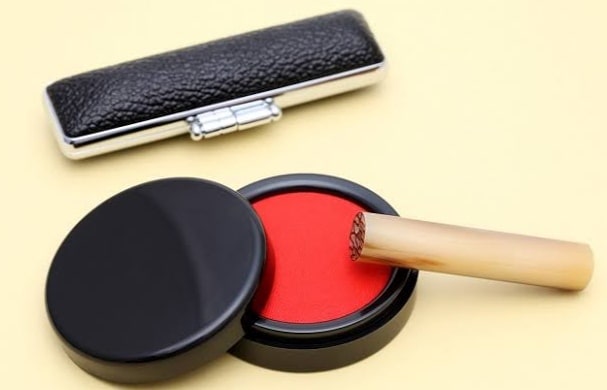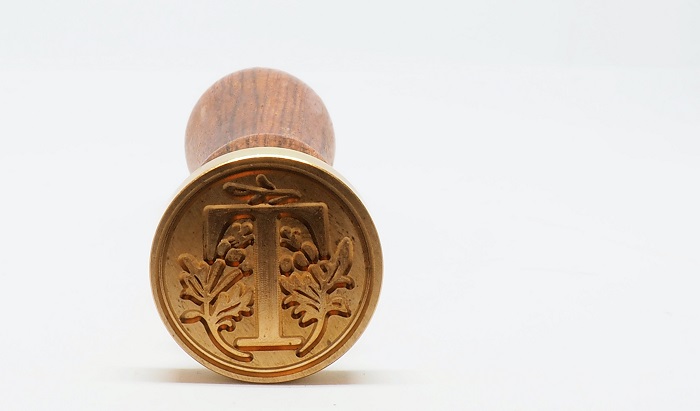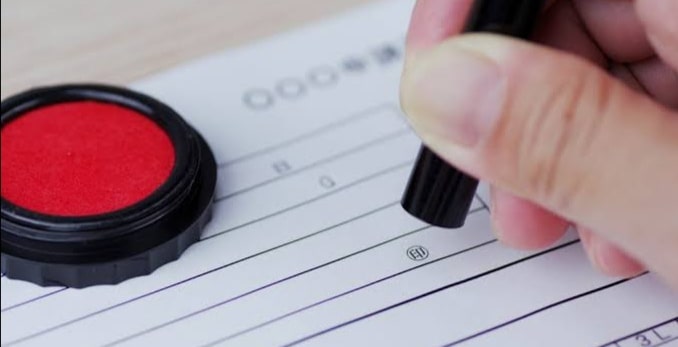Japan is known worldwide for preserving its own cultural and historical significance, which proves the long-held Hanko practice.
Although Hanko’s custom started in the eighth century, its usefulness is an indispensable part of Japanese life. They use this stamp in several things, particularly in authorizing a contract.
Aside from locals, foreign nationals in Japan also require to use a Hanko. In this article, you will know a few reasons why having such Japanese stamps is necessary when working and living in Japan.
But before that, let us know what Hanko is and the two types recommended for foreigners in Japan.
Table of Contents
What is Hanko?

Hanko is a personal seal, equivalent to your signature. When you sign a document, you usually use a pen, while people in Japan use a personalized stamp as a signature.
This personal stamp size ranges from 13.5 mm to 5 mm in diameter, and the cost will vary depending on the materials used. The inexpensive version, known as Sanmonban, often made of plastics is available in yen shops. But if you prefer a customized one, made from wood or other materials, then you should go to a Hanko shop.
Since non-Japanese names contain more characters than Japanese, it is preferable to carve your last name or only first in katakana. And an inkpad is used to dip your Hanko stamp and pressed it onto a document to leave a mark or print, known as Inkan.
There are different types of Hankos in Japan. For individual use, there are four major types: Ginkōin, Jitsuin, Mitomein, and Sanmonban. On the other hand, if you run a business in Japan, you will need a Kaishain or a company Hanko.
A foreigner living or working in Japan, does not have to get all those types of Hankos, just these two.
- Jitsu-in – A personal registered seal. You will need to visit a city hall or a ward office to have your Hanko registered.
- Ginko-In- A personal seal essential when you open a bank account and when you withdraw more than 500,000 yen in one transaction.
Although Mitome-in is used for everyday living, this kind of Hanko is unregistered and doesn’t pose legality.
For Hanko as a souvenir, please read our article Hanko: the best souvenir from Japan!
Reasons to get Hanko

As a foreigner, will you need to purchase a Hanko in Japan? Well, there are some instances that you will require to use it. Read on the following reasons below to understand why you should obtain a personal seal when working or living abroad in Japan.
1. Hanko is Useful when you sign a contract!
Signing any from the listed transactions below will require you to have your Jitsu-in stamp ready. But make sure to have it registered in a city office before you use it. A registered Jitsuin will verify that you are eligible to sign the following contracts.
Then, secure the “inkan card” that will be issued to you after the registration of your Jitsu-in because you will show you it after pressing your seal in a contract as proof that your inkan or the marked seal is legally registered.
Renting an accommodation
Along with your Hanko, you need your certificate of residence, residence record or juminhyo, proof of income, documents for surety, bank account passbook, and money for the initial cost. You will bring this to the rental office. Sign the contract with your Jitsuin before moving into the house.
In signing the lease or rental contract (chintai keiyaku), make sure to read the terms and conditions. Always have the terms explained to you before signing the contract. Your seal or signature will legally bind and will indicate that you agree with the specified right and obligations printed on the chintai keiyaku.
The validity of the contract depends on the type of the lease. The Normal Lease Contract will let you renew after the expiration. On the other hand, the Fixed Term Lease Contract will not be renewed automatically and will require you to enter a new contract to rent a new unit.
Purchasing a car
If you are planning to purchase or loan a car in Japan, use your Jitsuin as a stamp seal. As this involves a large amount of loan, car shops require an official seal that will let them trace the buyer’s information. You see, everything about you is connected through your Jitsuin as this is registered at your city office.
The lease includes the obligation of paying the depreciation of the car and will let you either give the car back or purchase the car at the end of the lease. As for the signing of the contract, this will take place when the loan application is approved. When the car loan company delivers the car to you, sign the final contract.
Signing job contract

There are three types of job contract(雇用契約, Koyō keiyaku) in Japan namely: Permanent Employee, known as Sei-sha-in;Contract Employee, known as Keiyaku sha-in; and Outsourced or Temporary Employee, known as Haken sha-in. Each contract entails the rights and responsibilities of the foreign worker. The validity of each contract differs.
Hanko is needed to prove your identity and admit that all information you filled out is true and sensible. Make sure to read all the information before signing the contract. All of the contents in the contract papers are hereby signed with your official seal.
2. It is Essential when opening a bank account!
In Japan, you also need to be verified when handling the financial matter. By using your Ginko-in as a signature, banks will trust you as a responsible foreigner in opening a bank account or getting a loan. This way, legal matters will be settled smoothly when problems occur.
Reminders:
- Aside from your hanko, you will need to bring your identity documents and telephone number.
- Please also note that most banks do not only require your pen signature, but your official bank hanko too.
- You can only open an account if you have a long-term stay visa.
3. Hanko is Required when paying taxes !
Foreign workers in Japan are required to pay their taxes annually. When paying your taxes before March 15 of the year, bring your official stamp or your Jitsuin. This will verify that they have done their responsibility as a taxpayer and will make their work life in Japan hassle-free.
When paying taxes in Japan, you will need to fill up forms, which depends on your income source, and will need a stamp to verify your identity. As this is an official matter, Japan requires foreign workers to use hanko stamps(Jitsuin) to show the confidentiality and integrity of the documents.
4. It is Handy and easy to purchase!
Hanko is portable as a pen does. You can bring your hanko everywhere especially when handling legal things in Japan. The consistency of the signature made by the stamp will also leave a good impression. Very handy indeed!
Aside from being handy, hanko is very easy to purchase. You can find hanko shops in Japan, either online or physical stores. The truth is you just need to select your hanko style, write down your desired seal, and hanko shops will do it for you. Easy!
Purchasing hanko from online shops is also highly recommended. As physical hanko shops offer authentic hanko, so do online shops. The best thing about online hanko shops is it doesn’t require you to commute and ride transportations. You can just ask the online hanko shop to deliver your order through parcel services.
Steps to get Hanko in Japan?

To make your Hanko valid, you need to register them at their respected registration places. If not, your Hanko will not have legal standing. That is why you need to know where to register them for validation.
Jitsu-in or Registered Seal
This seal is used for signing a contract, getting a house, and even setting up a company. Register this kind of Hanko at your city office.
Ginko-in or Bank Seal
These seals as the name suggests will be used for setting up bank accounts and getting a loan. Register this Hanko at your selected bank.
Now, how to get a Hanko?
- First, order your Hanko from a Hanko shop or hankoya. This will be done in around three days or a week. This depends on your selected material. There are a lot of physical Hanko shops in Japan.
- You can also order Hanko from online Hanko shops.
- After finding a store, select the material you desire. You can choose from a wooden Hanko, silver, or a titanium-made Hanko.
- Then, select your hanko size. The sizes depend on the diameter. The sizes are from 8 mm to 25 mm. You can also choose the type, which is round or square.
- Next, select your desired font style. Write the name(be it in English, Hiragana, Katakana, or Kanji) you wanted to be carved onto the seal. Please note that you have to use your first and last name to register it successfully. Some hankos will not be accepted because of the common names.
To avoid having Hanko rejected during the validation process, you must pay attention to the seal fonts to use. You can opt to pick any from these fonts:
- Kissoutai (吉相体): Also known as Insoutai (印相体) An old Chinese character-based fonts, commonly used for Ginko-in seals.
- Kointai (古印体): A traditional script with rounded edges and easier to read.
- Tenshotai (篆書体): Unlike Kointai, this old seal script is not easy to read. It has symmetrical elements and is popular to use for Jitsu-in seals as it looks very official.
- Gyoshotai (行書体): semi-cursive style font, which descended from an old clerical script. It looks like hand brush writing.
- Kaishotai (楷書体): Basic font style, squared appearance, and usually used on postcards.
- Reishotai (隷書体): Known as “clerical script,’ this highly legible font originated in China has a highly rectilinear structure.
- Review your hanko design. Lastly, pay for your order. Some shops accept credit cards but some only accept cash. You can also avail of the delivery up to your front door.
- Now, get your hanko registered.
- To do this, bring your hanko with your residence card to the inkan registration section at your local city office for your Jitsu-in and at your bank for your Ginko-in.
- For your Jitsuin, fill up a form and pay the registration fee. The registration cost varies, so please visit your city office.
Lost Hanko- What should I do?
There is a possibility that your Jitsuin will be stolen. This is ruinous because your Hanko has the power to sign everything, which can be used for malicious motives. If this happens, report it to the police authority right away. Request for the FREE cancelation of your Hanko. To do this, you need to bring out your inkan card and one of your identity documents, your residence card, and your “My Number” card.
For instance, if you have lost or misplaced your Jitsuin, order one first before registering it at your city office. The same with the process of a stolen Hanko, you need to cancel your previous, lost Hanko, fill up the Hanko registration form, and pay for the registration fee. Another inkan card will be given to you while you’re at it.
As for your Ginko-in, you need to register a new one if the old one was lost or stolen. If you have many bank accounts, you need to register one for each account at their respected financial institution. If you don’t want to experience banking problems, secure your Ginko-in or bank seals.
Living abroad in Japan requires a lot of adjustments, including the use of traditional Japanese stamps. It is a way of embracing a new culture and tradition that is totally different from yours.
Does this follow that you are obliged to get a Hanko stamp? Of course not. Unless for some legal transactions as mentioned in this article, you surely need to get one.
Hanko is clearly useful for foreigners, particularly those having a student visa and other long-term Japanese visas. It is not only handy but having a seal legally registered will undoubtedly make your banking and other transactions run smoothly in Japan.
Whichever your reason for obtaining it, the provided information above will for sure help your Hanko seal validation process successful. Get one now!
 日本語
日本語








